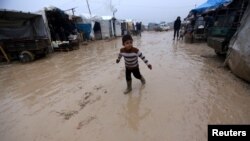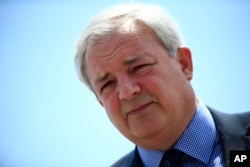The United Nations said Thursday that it is still facing significant Syrian government-imposed obstacles that are hampering the delivery of life-saving aid to scores of civilians in the war-torn country.
“We have capacity to deliver to hundreds of thousands of people in besieged and hard-to-reach areas every month and we are ready to move,” U.N. aid chief Stephen O'Brien told the U.N. Security Council in his monthly update on Syria. “The fault is not at the door of the U.N. or the NGOs it is the Syrian government and the [local] governors,” he said.
O'Brien ran through a litany of impediments imposed by the regime of Bashar al-Assad, including administrative hurdles, delays in approvals at the central and local levels, disagreements on access routes and violations of agreed procedures at checkpoints.
“We continue to be blocked at every turn,” he said.
Cease-fire holds
A nationwide cease-fire that went into effect on December 30 has largely held and there has been movement on the political track, with the two Syrian sides meeting face-to-face for the first time in many months in Astana earlier this week. But despite these first glimmers of hope, thousands continue to lack food, clean water and medical treatment in more than a dozen parts of the country. Severe winter conditions have further complicated their predicament.
“Sadly, in recent months, we have too often been unable to translate hope into humanitarian action,” O'Brien said.
Nearly 644,000 Syrians continue to live in areas considered to be besieged, an improvement since eastern Aleppo was evacuated last month, but the tactic is still being wielded as a weapon of war. Another 4.2 million are in hard-to-reach areas after nearly six years of conflict that has killed a half million people.
Islamic State
Where the government is not hindering the humanitarian response, the so-called Islamic State is.
In Deir Ezzor, O'Brien expressed concern for more than 93,000 civilians in the western part of the city who are under siege by the terror group. “Since 15 January, ISIL reportedly took control of several areas, including the main road and the Deir Ezzor airport, and is gaining ground in several more areas, splitting the besieged enclave in two,” the aid chief said.
The fighting led to a suspension of air drops by the World Food Program because the landing areas are now in IS-controlled zones.
O'Brien also expressed concern for more than 400,000 civilians in the IS-controlled Raqqa district, where the U.N. and its partners were last able to deliver aid more than three years ago. Fighting there has also displaced tens of thousands and damaged water and power stations.
IS areas are not included in the nationwide cease-fire.
'Horrendous chapter' needs to end
O'Brien urged the Security Council to ensure the current cease-fire is respected, that civilians are protected and all sieges are lifted. He urged support to his political colleague, U.N. envoy Staffan de Mistura, who hopes to restart another round of intra-Syrian talks in early February in Geneva.
“After a chronicle of missed opportunities, this is the time for the various parties to come together and bring an end to this horrendous chapter in Syria's history,” O'Brien said.












